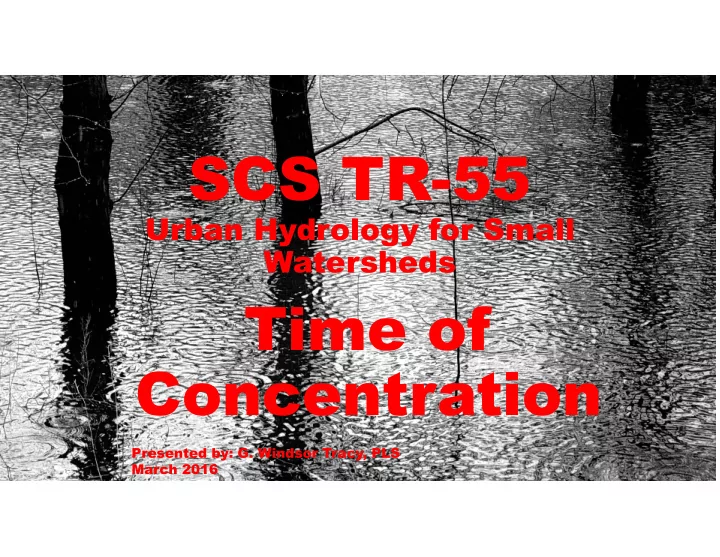

SCS TR-55 Urban Hydrology for Small Watersheds Time of Concentration Presented by: G. Windsor Tracy, PLS March 2016
Presented by: G. Windsor Tracy, PLS • 30 years experience • Licensed in 1993 • 10 years self employed • Performed Hydraulic & Hydrologic Studies for various size projects 10/3/2017 2
Introduction • Time of Concentration • Travel time ( T t ) is the time it takes water to travel (distance) from one location to a Point of Interest (POI) in a watershed. • T t is a component of time of concentration ( Tc ) • Time of concentration ( Tc ) is the sum of Tt values for the various consecutive flow segments: • Tc = T t1 + T t2 + T t3 + ….. [eq. 3-2] 10/3/2017 3
• Time of Concentration • Tc influences the shape and peak of the runoff hydrograph. • Urbanization usually decreases Tc, thereby increasing the peak discharge. • Tc can be increased as a result of: • ponding though inadequate drainage systems • reduction of land slope through grading • Minimum Tc is 0.1 Hours 10/3/2017 4
• Other Factors effecting Time of Concentration • Surface roughness • Smooth – Concrete • Moderate – Grass • Rough – Woods • Channel Shape • V shape vs. Trapezoid • Slope • Flat vs. Steep 10/3/2017 5
• Travel Time Computations • Water moves through a watershed as: • Sheet flow • Shallow concentrated flow, • Open channel flow • Or some combination of these. 10/3/2017 6
• Travel time ( Tt ) is the ratio of flow length to flow velocity: T t = L / 3600V [eq. 3-1] • Where: • T t = travel time (hr) • L = flow length (ft) • V = average velocity (ft/s) • 3600 = conversion factor from seconds to hours. • Time of Concentration must be in HOURS 10/3/2017 7
Demonstration of paved vs. unpaved in time of concentration 10/3/2017 8
• Sheet Flow • Flows over plane surfaces • Usually occurs at or near the headwaters of the drainage area • Sheet flow is limited to 300 feet in maximum length by TR55 • Important as sheet flow is the most sensitive component of the TC. • Manning’s Roughness Coefficient • Ground surface slope 10/3/2017 9
10/3/2017 10
• Shallow Concentrated Flow • More concentrated flow than sheet flow • Begins after a maximum of 300 feet of sheet flow, flow becomes shallow concentrated flow • Travel time ( Tt ) is : T t = L / 3600V [eq. 3-1] • Where: • T t = travel time (hr) • L = flow length (ft) • V = average velocity (ft/s) • 3600 = conversion factor from seconds to hours 10/3/2017 11
• Average velocity is determined in figure 3-1 10/3/2017 12
• Open Channels • Determined by Manning’s equation or water surface profile information • Average flow velocity is usually determined for bankfull elevation 10/3/2017 13
• Geometric Elements of Channel Sections 10/3/2017 14
• Trapezoidal Swale Example • Given: • Base 10 feet • Depth is 4 feet, flow is 3 feet • Side slopes are 4:1 • Calculate to determine velocity • Given: • Concrete Swale • Slope = 3% • Length = 1000’ • Calculate Tc 10/3/2017 15
Recommend
More recommend